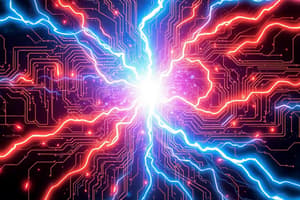Podcast
Questions and Answers
What is the primary purpose of an electrical outlet?
What is the primary purpose of an electrical outlet?
- To regulate the voltage levels in a building
- To transfer electrical energy from the power grid to appliances and devices (correct)
- To prevent electrical surges and disturbances
- To convert AC power to DC power for charging devices
Which type of outlet is specifically designed to protect electrical devices from voltage spikes and other electrical disturbances?
Which type of outlet is specifically designed to protect electrical devices from voltage spikes and other electrical disturbances?
- Wall outlets
- Surge protectors (correct)
- USB outlets
- Battery charging points
What is the primary function of USB outlets?
What is the primary function of USB outlets?
- To provide access to household electrical power
- To regulate voltage levels for sensitive electronics
- To protect against electrical surges and disturbances
- To provide an alternate method for charging electronic devices (correct)
Which type of outlet is commonly found in every home, providing access to household electrical power?
Which type of outlet is commonly found in every home, providing access to household electrical power?
What is the primary difference between an AC power outlet and a battery charging point?
What is the primary difference between an AC power outlet and a battery charging point?
What is a common configuration for wall outlets in a home?
What is a common configuration for wall outlets in a home?
Which of the following is a recommended safety practice when using electrical outlets?
Which of the following is a recommended safety practice when using electrical outlets?
What is the primary function of a single-pole switch?
What is the primary function of a single-pole switch?
Which type of switch allows you to control a light or device from two different locations?
Which type of switch allows you to control a light or device from two different locations?
What is a key feature that distinguishes smart switches from traditional electric switches?
What is a key feature that distinguishes smart switches from traditional electric switches?
What is a potential risk associated with overloading electrical outlets?
What is a potential risk associated with overloading electrical outlets?
Which component of an electrical system is essential for controlling the flow of electric current to various circuits and objects within a building?
Which component of an electrical system is essential for controlling the flow of electric current to various circuits and objects within a building?
Flashcards are hidden until you start studying
Study Notes
Electricity has become an integral part of our daily lives, powering everything from appliances and electronics to lighting and heating systems in homes and commercial buildings. Understanding the basics of electric supplies is crucial for ensuring safety and efficient energy consumption. This article will delve into two essential components of electric supply systems: outlets and switches.
Outlets
Electrical outlets, also known as power outlets, are devices designed to transfer electrical energy from the power grid to appliances and other electrical equipment through the process of plugging. They come in various types based on voltage levels, such as receptacle outlets for AC power and battery charging points for DC power. Here are some key aspects of outlets:
Types of Outlets
Wall Outlets
Wall outlets are common devices found in every home, providing access to household electrical power. These outlets can accommodate standard electrical plugs and range from single, double, triple, or even larger configurations.
Surge Protectors
Surge protectors are specialized outlets designed to protect electrical devices from voltage spikes and other forms of electrical disturbances that can damage or even destroy the equipment. They work by diverting excess current away from sensitive electronics, ensuring their safe operation while connected to the wall outlet.
USB Outlets
USB outlets provide an alternate method for charging electronic devices. These outlets have become increasingly common due to the widespread use of USB-powered accessories like smartphones, tablets, and headphones.
Safety Considerations
While outlets play a crucial role in delivering electricity to our daily lives, they also pose potential risks when not used properly. To ensure safety, consider these guidelines:
- Always plug appliances directly into wall outlets instead of using extension cords as the primary source of power.
- Avoid overloading outlets with too many devices and limit the number of devices on each circuit to prevent fire hazards and electrical surges.
Switches
Switches are essential components of any electrical system, allowing users to control the flow of electric current to various circuits and objects within a building. Here is some information about switches:
Types of Electric Switches
Electric switches come in different types based on their applications and design principles. Some common examples include:
Single-Pole Switches
A single-pole switch controls a light fixture or an electrical device by connecting or disconnecting one of its terminals to the ground terminal through a movable mechanical contact. This type of switch operates on an ON-OFF principle.
Three-Way Switches
Three-way switches allow you to control a light or other device from two locations without having to turn off and back on both switches at once. They consist of two identical three-way switches controlled by the same lever or handle.
Smart Switches
With advancements in technology, smart switches have emerged as an alternative to traditional electric switches. Smart switches come with WiFi, Bluetooth, Zigbee, or Z-Wave connectivity, enabling remote control via mobile apps or voice assistants like Amazon Alexa or Google Assistant. These intelligent devices offer added convenience, energy efficiency, and security features compared to conventional switches.
In conclusion, understanding the foundational aspects of electricity supply systems, particularly outlets and switches, is vital for maintaining safe and efficient residential and commercial spaces. By familiarizing ourselves with the functions, types, and best practices associated with electrical components, we can minimize risks and optimize our use of this essential resource.
Studying That Suits You
Use AI to generate personalized quizzes and flashcards to suit your learning preferences.




